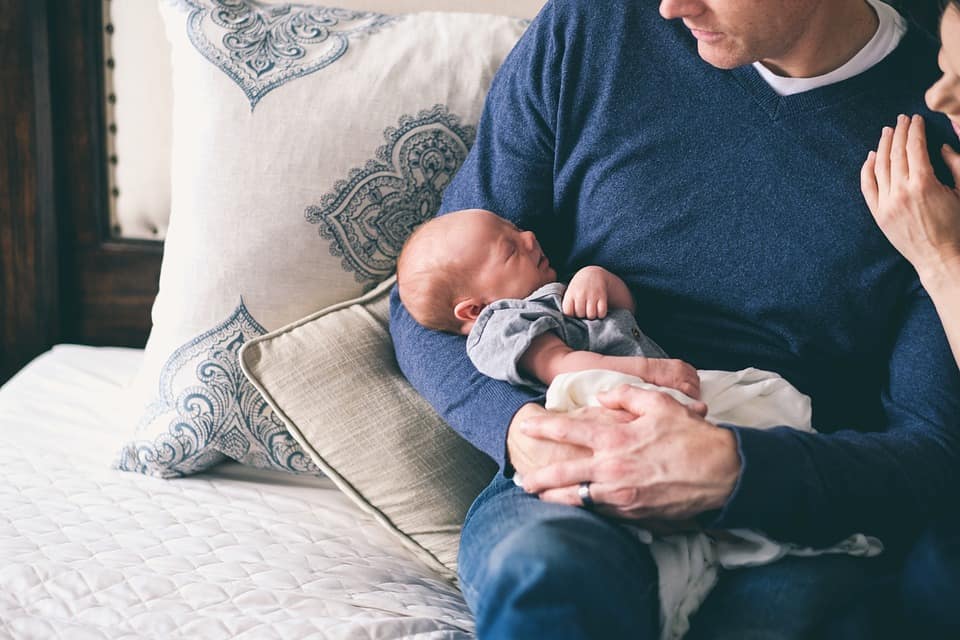Whether you have a baby or toddler, you will likely face sleep struggles during your parenting journey. Sleep training methods can be your tool for a successful night’s sleep. There are multiple methods available which I will review today.
As a Certified Pediatric Sleep Consultant, Registered Nurse, and mother of two, I have focused on creating healthy sleep habits from the very beginning days. Many families do not realize they can positively impact sleep in the newborn stage. After months of being sleep deprived, they turn to a sleep consultant for support and guidance on which sleep training method would be most suitable for their family.
Sleep training or teaching is my expertise. I love creating customized sleep plans with tailored sleep training methods to help improve sleep for the entire family. I will have the main sleep training methods explained and discuss hands-on approaches to sleep training.
Bottom Line
Sleep training is a process of teaching your baby they can fall asleep on their own. Therefore no feeding or rocking the baby to sleep. When babies fall asleep in the crib, they know where they are initially upon dozing off, which supports their ability to connect sleep cycles without relying on external sources. Since babies will have many shifts in sleep cycles at night, a baby knowing they can fall asleep on their own provides the skill set for them to do so with each waking.
Benefits of Sleep
If you are wondering how broken sleep can impact your baby or toddler, you will read this in the next section when I discuss signs of an over-tired or sleep-deprived child. Some families decide to sleep train due to sleep deprivation. Additionally, they appreciate the positive benefits a full night’s rest has on our physical, emotional, and mental well-being. The benefits of proper sleep for our babies include brain growth and maturation. Sleep impacts the ability to consolidate memories and impacts our children’s ability to learn. Infants and toddlers who have proper consolidated sleep at night score higher cognitively; compared to those that lack in the sleep department.
Achieving proper sleep a baby or toddler requires for optimal growth and development also plays a role in language ability, attention, impulse control, and mood regulation and allows them to be more adaptable.
Ideal Time to Sleep Train
If faced with the four or six-month sleep regression and your baby is being fed, bounced, or rocked to sleep, this is a great window to implement a sleep training method.
If sleep has been a positive journey the first year of life and now into the toddler stage, you are dealing with sleep deprivation, it can also be a great time to sleep train. Whether you have a newly 12-month-old, coasted for two years, or you co-slept for 4 years and feel it is time to work on independent sleep skills, all these ages are suitable for sleep training.
The ideal time to sleep train is when you believe broken or sporadic sleep negatively impacts you, your child, your partner, and/or the family unit. If you feel irritable, or withdrawn, are having mood swings and difficulty concentrating. If your reaction time is limited, these are some signs that sleep deprivation is taking a toll on your physical and mental well-being. The signs your baby may not be achieving adequate or consolidated sleep include: crying regularly, hysterically screaming, being withdrawn, irritable, turning away from you or stimulation, increased clinginess, or difficulty putting down. Signs your toddler is negatively impacted by lack of sleep include: crankiness, irritability, hyperactivity, clumsiness, difficulty waking up, and being quick to upset.
Additionally, you do not need a reason to sleep train, if you value healthy sleep habits and want your baby to not rely on being fed or rocked to sleep, you can still focus on implementing a sleep training method before sleep becomes problematic. The best way to do this is by laying a healthy foundation for positive sleep habits in the newborn days. You can build this up through the sleep training process as soon as you have received the green light from your healthcare provider.
From the perspective of an easier transition regarding the sleep training process, it is usually easier to sleep train around the 4-month mark vs. waiting until the baby becomes older. The older a baby or toddler becomes, the more ingrained their routine becomes. A baby fed or rocked to sleep for 4-months will likely have an easier time transitioning to falling asleep on their own vs. a child that has been rocked to sleep for 4-years. Toddlers become verbal, have opinions of what they like and do not like, and can move around their sleep space or room, causing the process of sleep training to be more taxing for the parent.
The other main factor to take into account when deciding on an optimal time to sleep train is your readiness and willingness to commit to the process of sleep training. It takes time to see successful results and time frames vary depending on a baby’s temperament and the sleep training method used. It is an ideal time to sleep train when you are ready to move forward with the process and genuinely ready to execute the sleep training method consistently.
There is no written rule that families need to go down the path of sleep training. If you are happy with your routine, your baby sleeps well and achieves the sleep they need developmentally, you can maintain your current practices if you feel all is well. It comes down to your family’s needs and what is best for everyone involved.
Sleep Training Methods
Extinction Method
When the term sleep training is used most people automatically view this as being the Extinction Method.
The extinction Method is the most well-known. This method involves putting the baby down, awake at bedtime after their routine, and leaving the room. Regardless of the time, it takes you to let the baby fall asleep on its own without any check-ins. Marc Weissbluth, an American Pediatrician created the extinction method and has written multiple books on infant sleep. This method has received backlash stating it can be traumatizing for the baby. However, no research supports any cry-it-out method as being harmful while using or having any long-term consequences. Many physicians still suggest this particular method or a variation of this method to their clients.
Pros of the Extinction Method
Parents often see positive results within 3-nights, a baby is falling asleep independently and sleeping either through the night or sleeping 6-8 hours, waking up and putting themselves back to sleep.
Cons of the Extinction Method
Parental upset and guilt. A baby crying for an undetermined length of time.
It is important to note that when using this extinction method you should have approval from a Pediatrician. It is important to be mindful that all babies have different needs when it comes to their nighttime feeds. I focus on a baby dropping their nighttime feed independently vs. parents dropping night feeds cold turkey.
Due to preserving the mother’s breast milk supply, the extinction method may not be suitable for certain families who prefer to hold onto the middle-of-the-night feed. Families all have different views of ways to feed their baby and only you as the parent can determine what is in your infant’s best interest.
Expert Sleep Tip
Working with a sleep consultant will help determine if your baby still requires a night feed. If they do, you can sleep train and still honor the baby’s need to receive the middle-the-night feed. You can successfully sleep train and still provide milk at night. A proper response plan is important for success while using a sleep training method and still offering a nighttime feed.
The extinction method is not inclusive of methods involving timed check-ins or responsive methods. Many people refer to cry-it-out methods as those involving a timed check-in approach. However, the actual cry-it-out approach is the Extinction Method.
Graduated Extinction/Extinction Method
The extinction Method evolved into Graduated Extinction, also known as Progressive Waiting Approach. The other names you may recognize within this category of sleep training includes; Ferber Method, controlled comforting, controlled crying, timed-interval approach, as well as check and console.
Not all experts agree on the Graduated Extinction approach as a cry-it-out approach since all of these usually involve parental intervention and comforting measures. Babies or toddlers are not left alone to cry it out until they fall asleep, rather parents are using timed intervals to attend to their baby for comfort and reassurance, or they are tuning into the cry and determining when to comfort based on the type or intensity of cry.
Of all the graduated extinction methods the most well-known is the Ferber Method. The Ferber method was created by Dr. Richard Ferber, author of “Solve Your Child’s Sleep Problems”. This method involves attending to the baby 3 minutes after laying them down. After providing reassurance parents are encouraged to leave the room and return in another 5 minutes. Throughout the night intervals continue to increase until the baby has fallen asleep independently. These intervals will increase to 30+ minutes in length if the baby has not fallen asleep before this time frame.
Here’s everything you need to know about the Ferber Method.
Pros of the Ferber Method
Parents often feel more at ease providing comfort or reassurance throughout the process. Positive results are noted within days of using this method. Some babies have minimal crying and can fall asleep within 5-15 minutes of the time they were placed down. Other babies may take 30-60 minutes to fall asleep.
Cons of the Ferber Method
Some babies will increase their crying when they are being comforted. That is often when the baby would prefer the method they are used to receiving to fall asleep, such as rocking or feeding to sleep. Parents may find it difficult not to revert to feeding or rocking to sleep, which will impact the ability to see positive results from the process.
Expert Sleep Tip
Having the ideal wake window length before bedtime can make the sleep training process easier. A baby or toddler placed down too soon will often cry more due to protesting not being tired enough which can prolong the process of falling asleep. Just as much as an over-tired baby will have a difficult time falling asleep, resulting in longer durations of crying.
Controlled Comforting/Controlled Crying/Check and Console
These terms are all variations of Graduated Extinction/Ferber Method, how long you wait to go in and comfort the baby all depends on who you ask. Most sleep consultants have created their spin on these methods and finding a method that resonates with you and your comfort level can make a positive difference in your ability to be consistent.
For example, some families or sleep consultants may use one specific timed interval to check in on the baby. They may choose a duration of time they feel most comfortable with rather than increasing the duration of time for each interval check. This may look like checking on the baby every 5 minutes if the baby is still crying, check-ins continue until the baby has fallen asleep. Some sleep consultants will discuss the different types of crying. That will help parents determine when to go into the room and console based on the type of cry, whether this determines fussing, protesting, or a heightened cry.
All these methods encourage a baby to fall asleep on their own. Parents should avoid having the baby fall asleep while eating, being rocked in the arms of mom or dad, or during the transfer to their sleep space.
The level of support and comfort provided during each ins can also vary greatly depending on who you ask. Some sleep experts will encourage parents not to pick up their baby, pat them briefly to provide comfort and leave the room within 30-60 seconds. Other sleep experts encourage parents to use their intuition and pick up their baby if required but the goal would be placing the baby back down awake and repeating the process of check-ins.
As a sleep expert myself who has worked with hundreds of families already, I there is no size fits all of the sleep training. It’s always best to adapt methods based on the parental comfort level and temperament of the baby, this is when you see success in using a method and achieving the desired results.
These methods can be adapted in many ways to suit each family’s needs. Not all babies do better with frequent check-ins and will become more upset with each comforting session.
When we focus on sleep training, we want to focus on a method most suitable for each baby. If checking on your baby every 5 minutes to provide reassurance is elevating their crying, it would be in the best interest, to reassess what this should look like.
Pros of Controlled Comforting/Controlled Crying/Check and Console
Parents may have a higher likelihood of falling through with a method that resonates with them and meets their comfort level. If maintain consistency in your approach, positive results can still be seen by night 5. Parents may view these methods are gentler options since they may feel more hands-on.
Cons of Controlled Comforting/Controlled Crying/Check and Console
Parents may find being more hands-on or checking in during shorter durations may upset their baby, That has the potential to prolong the process depending on the baby’s temperament.
Expert Sleep Tip
regardless of the sleep method chosen, the first 5-nights are usually the hardest, even with the most hands-on or gentle approach. I highly encourage families to maintain consistency with their effort for the first 5-nights to avoid confusing the baby or toddler with parental inconsistencies in using a sleep training method.
Pick Up/Put Down Method
The Pick Up/Put Down sleep training method is known to be hands-on and therefore viewed by some to be a gentler method. This particular method derived from Tracy Hogg, who wrote the book; “Secrets Of The Whisperer”. Parents would follow the bedtime routine, keeping their baby awake and avoiding the baby falling asleep via feeding or motion. Once finished with the routine parents place their baby down. If the baby becomes upset, parents are to pick up their baby, calm them down, and re-try. This process would repeat itself, putting the baby into its sleep space and picking up when necessary until the baby has fallen asleep on its own.
The pick-up, put-down sleep training method can work but often takes longer in comparison to the above-mentioned sleep training methods. Not only may it take longer, but it may also still produce tears. A baby may still cry during this process as the routine of putting them down awake is different from what the baby is used to receiving if previously rocked or fed to sleep.
Pros of Pick Up/Put Down Method
Parents may feel this hands-on approach to sleep training is one they can execute since they can respond to the crying as needed through pick-ups.
Cons of Pick Up/Put Down Method
Parents may find the process taxing picking their baby up and placing it back down for extended periods. A baby can become over-stimulated with all the action and we know an over-tired baby will naturally have a harder time falling asleep which can prolong this process.
Expert Sleep Tip
practicing placing your infant down drowsy can be a great gateway into the pick-up, put-down sleep training method. When we start with placing a baby down in a drowsy state, over time we are helping to teach them how they can fall asleep on their own.
You may be wondering what length of time it can take to see successful results from the pick-up, put-down method. All babies adapt to sleep training methods at their own pace, this particular method can take 1-2 weeks to see full results.
Shush/Pat Method
The Shush/Pat sleep training method is another hands-on approach to teaching a baby to fall asleep independently. This technique was also developed by Tracy Hogg and allows parents to be hands-on during the bedtime process. Once the bedtime routine is complete, you place the baby into their sleep space and start to gently shush and pat the baby to help calm them down, if the baby starts to show sleepy eyes, parents slowly lessen the support they provide.
The goal is to lessen your support each night and try to withdraw touch before the baby falls asleep. However, if the baby becomes upset or startled, parents return to shushing and patting to help calm the baby down. This is a process that can teach a baby how to fall asleep at bedtime.
If using this method, I would encourage parents to maintain consistency for a full two-week duration or until desired results are achieved.
Pros of Shush/Pat Method
Parents can be involved and hands-on to help teach their baby to fall asleep, which may align with certain parenting styles.
Cons of Shush/Pat Method
Parents may find standing over the crib physically taxing and may not follow through with consistency. Some babies would find this method stimulating and cry louder vs. if parents handed it off. The older a baby the less likely this method will be effective for them.
Since this is a very hands-on method and technically can be used over time, parents can adapt this method to suit their needs. Meaning they can start using this method at a younger age as they can be as responsive as they choose to be.
Expert Sleep Tip
If you place a baby down and they are content, do not jump the gun and start patting and shushing to help them fall asleep. Take a step back and give the baby some space and time. If you have worked on setting a healthy sleep foundation from the start, you may be surprised your baby does not require as much hands-on support as you may have suspected they may need.
Chair Method
The Chair Method can be used for babies or toddlers. Depending on who you ask, there may or may not be physical support or reassurance provided during this process. The idea is to place your child into their sleep space and instead of leaving the room, you would sit directly beside their sleep space. Some sleep experts would encourage limiting physical and verbal support, whereas others would encourage a plan of action in using some support and lessening the support provided over time.
The concept is having parental presence may help your little one feel secure and therefore have an easier time falling asleep knowing mom or dad is close by. Every few days the chair would move slightly further away from the sleep space. The first 3 nights the chair can be directly next to the crib or bed and then moved slightly away, continuing to shift further from the bedside until the chair eventually is outside of the room.
The chair method can be very effective for sleep-training toddlers who are used to having a parent next to them as they fall asleep. For families who have been co-sleeping for some time, I usually encourage easing into the process of sleep training. I have personally used the chair method with my clients but created a customized plan with step-by-step actions on how we can lessen the support. Many families find it helpful to have sleep goals and work towards each milestone, which can help with accountability and consistency.
Bedtime Routine Fading/Bedtime-Hour Fading
Using the bedtime fading method can help those who are breaking away from sleep associations but struggle with their baby or toddler protesting the process of falling asleep, or for those falling asleep much later in the evening. If you have moved away from feeding or rocking your baby or child to sleep but the process of them falling asleep still results in tears, the time you are placing them down may not align with their sleep drive.
A baby or toddler’s sleep drive is their ability to fall asleep based on being tired enough, this comes down to having the proper amount of wakeful period before offering them the opportunity to fall asleep. The fading sleep training method allows the sleep schedule to be based on the baby’s circadian rhythm.
When you determine the time your baby or toddler naturally falls asleep, this will become the baseline. You can record the time your baby/toddler falls asleep at bedtime for 5 consecutive nights. That will determine what time to start their bedtime routine.
If you want your baby to fall asleep 15-20 minutes earlier, you would shift the bedtime routine to start 15-20 minutes earlier. Every few days you can shift the routine to start slightly earlier until you reach an ideal time. Usually, bedtime is best between 7:00-8:00 pm for babies beyond 3 months of age.
FAQs – Sleep Training Methods Explained
Question: What age is easiest to sleep train?
Answer: Most healthcare professionals and sleep experts recommend sleep training between 4-6 months of age. Most babies within this age no longer need a middle of the night feeds and those who do require a night feed can still learn to fall asleep within feeding to sleep, which will naturally allow longer stretches of sleep to occur.
Question: What is the most effective sleep training method?
Answer: The most effective sleep training method is the one a parent will maintain consistency until desired results. The most well-known sleep training methods that produce the fastest results include: the extinction method or graduated extinction, also known as the Ferber Method, modified extinction, check and console, timed-interval approach, or controlled crying/comforting method.
Question: How long does sleep training take?
Answer: Sleep training can improve sleep within 3-5 days or within 2-4 weeks depending on the sleep training method chosen. How well a parent can maintain consistency will play a vital role in how quickly results are seen. Making sure to sleep train when a baby is of proper age is also imperative for safety and success.
Question: Does sleep training work?
Answer: Yes. Sleep training studies have shown to improve a baby or toddler’s ability to fall asleep on their own and achieve consolidated stretches of sleep. This helps lessen middle-of-the-night wakings and allows a baby or toddler to connect sleep cycles independently, therefore allowing everyone in the home to have a better night’s rest.
Final Thoughts:
Sleep training can be the key to a successful night’s sleep if your baby or toddler is struggling to fall asleep, having multiple night wakings where they need assistance in falling back asleep, or if they are awake for hours on end in the middle of the night. Deciding to sleep train is a very personal decision, it is always best to think about your parenting style, your child’s temperament, and if lack of sleep is negatively impacting your family.
Once you determine achieving a full night’s sleep is not only beneficial for you as the parent but most importantly for your growing baby or toddler, it would be wise to discuss with your partner and come to an agreement. Having the support of your partner can make a world of difference in successful sleep training results.
If you are hesitant to sleep train on your own there are many certified sleep consultants available to help support you in this process. The success of sleep training is not only the method you select but an accumulation of proper daytime sleep, ideal wake windows, sleep cues, creating a routine, and bedtime rituals. If you decide to go down the route of hiring a sleep consultant, it is always best to read their reviews.
Ideally, connect with them before hiring and understand their sleep training style or preferred method. The most suitable sleep consultant is someone who will work with your family and provide a plan suitable to your comfort level and also your little one’s temperament.
Kayla is a mama of two littles, each born during the Covid-19 pandemic. Prior to becoming a mom, she worked as a Registered Nurse for 12 years. Now as a Certified Pediatric Sleep Consultant, she owns and runs Serenity Sleep Consulting full time.
After having her first baby, sleep deprivation hit hard. She was desperate for rest and knew she needed to focus on establishing a healthy sleep foundation. Kayla researched infant sleep and started to focus on what she likes to call Sleep Shaping. Her son went from waking every hour to sleeping 4-5 hour stretch, followed by 6-8 hours, and eventually 12 hours at 3 months of age. This method has turned into her signature service, it allows her to provide education and tools to help families with newborns. She also works with those who have babies 4 months upwards of 4-5 years.
We all function at our optimal level with a full night’s rest and Kayla loves to support parents in this journey!







